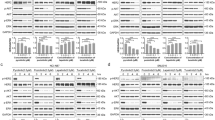Abstract
Glioblastoma is an aggressive malignancy, which is notorious for its poor prognosis. Although Temozolomide (TMZ) has been showed to be an effective chemotherapeutic agent for glioblastoma treatment, the response rate is far from satisfactory. As a natural compound with anti-cancer activity against a variety of cancers, Hispidulin is a good candidate drug for combination therapy. This study is designed to determine whether Hispidulin could potentiate the anti-tumor activity of TMZ in glioblastoma. Cell proliferation and apoptosis were determined by MTT assay and Hoechst staining, respectively. Expression of proteins relevant to apoptosis and proliferation was detected by Western blotting. Our in vitro assays showed that Hispidulin enhanced the anti-tumor activity of TMZ in glioblastoma by both inhibiting cell proliferation and inducing cell apoptosis. The anti-tumor activity of Hispidulin and the enhanced TMZ anti-tumor activity by Hispidulin induced the activation of AMPK signaling pathway. Our results showed that Hispidulin, by activating AMPK, exhibited anti-tumor activity and potentiated the anti-tumor activity of TMZ in glioblastoma. Although further preclinical and clinical studies are needed, this study provides insight for using Hispidulin as a chemosensitizing agent in clinic settings.




Similar content being viewed by others
References
Ostrom, Q. T., et al. (2013). CBTRUS statistical report: Primary brain and central nervous system tumors diagnosed in the United States in 2006–2010. Neuro Oncology, 15(Suppl 2), ii1–ii56.
Lin, G. S., et al. (2014). STAT3 serine 727 phosphorylation influences clinical outcome in glioblastoma. International Journal of Clinical and Experimental Pathology, 7(6), 3141–3149.
Stupp, R., et al. (2005). Radiotherapy plus concomitant and adjuvant temozolomide for glioblastoma. New England Journal of Medicine, 352(10), 987–996.
Quick, A., et al. (2010). Current therapeutic paradigms in glioblastoma. Reviews on Recent Clinical Trials, 5(1), 14–27.
Chamberlain, M. C. (2010). Temozolomide: Therapeutic limitations in the treatment of adult high-grade gliomas. Expert Review of Neurotherapeutics, 10(10), 1537–1544.
Zhang, J., Stevens, M. F., & Bradshaw, T. D. (2012). Temozolomide: Mechanisms of action, repair and resistance. Current Molecular Pharmacology, 5(1), 102–114.
Tentori, L., & Graziani, G. (2009). Recent approaches to improve the antitumor efficacy of temozolomide. Current Medicinal Chemistry, 16(2), 245–257.
Bourdillat, B., et al. (1988). Mechanism of action of hispidulin, a natural flavone, on human platelets. Progress in Clinical and Biological Research, 280, 211–214.
He, L., et al. (2011). Hispidulin, a small flavonoid molecule, suppresses the angiogenesis and growth of human pancreatic cancer by targeting vascular endothelial growth factor receptor 2-mediated PI3 K/Akt/mTOR signaling pathway. Cancer Science, 102(1), 219–225.
Tan, R. X., et al. (1999). Mono- and sesquiterpenes and antifungal constituents from Artemisia species. Planta Medica, 65(1), 64–67.
Yu, C. Y., et al. (2013). Potential Therapeutic Role of Hispidulin in Gastric Cancer through Induction of Apoptosis via NAG-1 Signaling. Evidence-Based Complementary and Alternative Medicine, 2013, 518301.
Gao, H., Wang, H., & Peng, J. (2014). Hispidulin induces apoptosis through mitochondrial dysfunction and inhibition of P13 k/Akt signalling pathway in HepG2 cancer cells. Cell Biochemistry and Biophysics, 69(1), 27–34.
Yang, J. M., et al. (2010). Hispidulin sensitizes human ovarian cancer cells to TRAIL-induced apoptosis by AMPK activation leading to Mcl-1 block in translation. Journal of Agriculture and Food Chemistry, 58(18), 10020–10026.
Lin, Y. C., et al. (2010). Hispidulin potently inhibits human glioblastoma multiforme cells through activation of AMP-activated protein kinase (AMPK). Journal of Agriculture and Food Chemistry, 58(17), 9511–9517.
Cheng, H., et al. (2011). In vitro sequence-dependent synergism between paclitaxel and gefitinib in human lung cancer cell lines. Cancer Chemotherapy and Pharmacology, 67(3), 637–646.
Huang, H., et al. (2011). Gambogic acid enhances proteasome inhibitor-induced anticancer activity. Cancer Letters, 301(2), 221–228.
Chou, T. C., & Talalay, P. (1984). Quantitative analysis of dose-effect relationships: The combined effects of multiple drugs or enzyme inhibitors. Advances in Enzyme Regulation, 22, 27–55.
Kopelovich, L., et al. (2007). The mammalian target of rapamycin pathway as a potential target for cancer chemoprevention. Cancer Epidemiology Biomarkers & Prevention, 16(7), 1330–1340.
Garami, A., et al. (2003). Insulin activation of Rheb, a mediator of mTOR/S6 K/4E-BP signaling, is inhibited by TSC1 and 2. Molecular Cell, 11(6), 1457–1466.
Zhang, J. F., et al. (2007). Rapamycin inhibits cell growth by induction of apoptosis on hepatocellular carcinoma cells in vitro. Transplant Immunology, 17(3), 162–168.
Romano, M. F., et al. (2004). Rapamycin inhibits doxorubicin-induced NF-kappaB/Rel nuclear activity and enhances the apoptosis of melanoma cells. European Journal of Cancer, 40(18), 2829–2836.
Yuan, Y., et al. (2012). Resveratrol enhances the antitumor effects of temozolomide in glioblastoma via ROS-dependent AMPK-TSC-mTOR signaling pathway. CNS Neuroscience & Therapeutics, 18(7), 536–546.
Gong, A., et al. (2014). Aplysin enhances temozolomide sensitivity in glioma cells by increasing miR-181 level. Cancer Chemotherapy and Pharmacology, 74(3), 531–538.
Kunnumakkara, A. B., et al. (2008). Curcumin sensitizes human colorectal cancer xenografts in nude mice to gamma-radiation by targeting nuclear factor-kappaB-regulated gene products. Clinical Cancer Research, 14(7), 2128–2136.
Saha, A. K., et al. (2006). AMPK regulation of the growth of cultured human keratinocytes. Biochemical and Biophysical Research Communications, 349(2), 519–524.
Motoshima, H., et al. (2006). AMPK and cell proliferation–AMPK as a therapeutic target for atherosclerosis and cancer. Journal of Physiology, 574(Pt 1), 63–71.
Yu, S. Y., et al. (2009). Inhibition of cervical cancer cell growth through activation of upstream kinases of AMP-activated protein kinase. Tumour Biology, 30(2), 80–85.
Inoki, K., Zhu, T., & Guan, K. L. (2003). TSC2 mediates cellular energy response to control cell growth and survival. Cell, 115(5), 577–590.
Wang, W., & Guan, K. L. (2009). AMP-activated protein kinase and cancer. Acta Physiologica (Oxf), 196(1), 55–63.
Cheng, S. W., et al. (2004). Thr2446 is a novel mammalian target of rapamycin (mTOR) phosphorylation site regulated by nutrient status. Journal of Biological Chemistry, 279(16), 15719–15722.
Author information
Authors and Affiliations
Corresponding author
Rights and permissions
About this article
Cite this article
Wang, Y., Liu, W., He, X. et al. Hispidulin Enhances the Anti-Tumor Effects of Temozolomide in Glioblastoma by Activating AMPK. Cell Biochem Biophys 71, 701–706 (2015). https://doi.org/10.1007/s12013-014-0252-6
Published:
Issue Date:
DOI: https://doi.org/10.1007/s12013-014-0252-6




